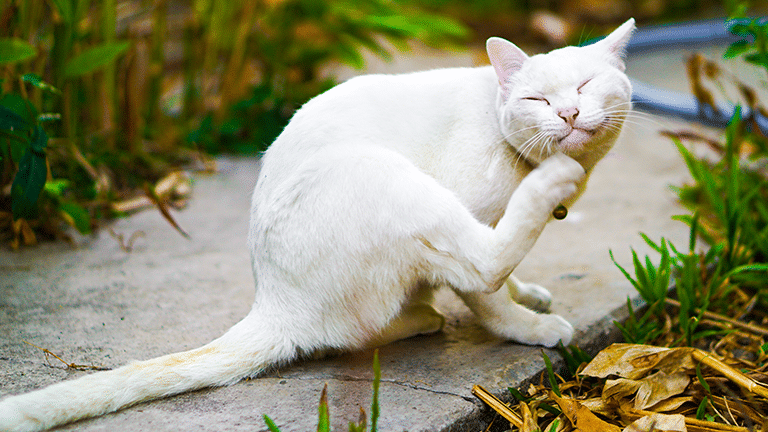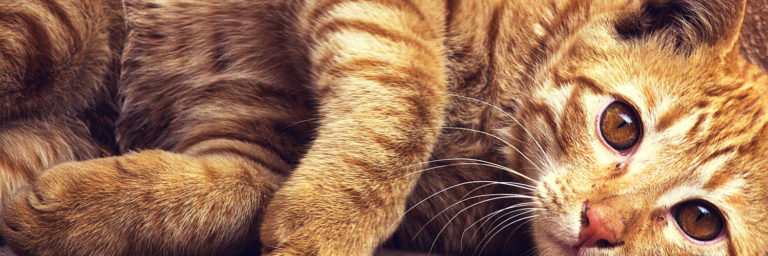Hot Spots on Cats: Causes, Symptoms and Treatment Options for Itchy Cats
Contents of Article
Hot spots on cats are more than itchy patches of skin. They’re oozing, raw indicators that your cat is suffering from deeper physical or psychological problems. While it’s easy to heal your cat’s raw skin at home, your real, and often long-term, challenge is identifying and eliminating the root cause of your cat’s hot spots.
In this article, you’ll learn what causes hot spots on cats, how to heal them, and how to identify and treat the underlying conditions that make hot spots happen.
What are hot spots on cats?
Also known as pyotraumatic dermatitis, acute moist dermatitis, or miliary dermatitis, hot spots
are a skin infection that results in severe itching and oozy, juicy skin lesions. The infection results in skin that’s hot to the touch—hence the name.
What causes hot spots on cats?
Hot spots typically develop as the result of minor irritation caused by fleas, allergies, or another source of itchiness or pain. If your cat scratches, chews, gnaws, or licks himself too much, the natural bacteria will infect the irritated skin, creating a vicious cycle of itching and re-irritation.
Pain is also a factor. Some cats try to alleviate joint or nerve pain by biting or scratching a certain part of their body. For instance, if your cat has ear mites or other ear itchiness, they might scratch the area around the ear until a hot spot develops.
Physical factors aren’t the only causes of hot spots. Stress and other mental issues could lead to compulsive licking and biting, which might cause a hot spot to develop.
They’re most common among cats with long, thick hair, which creates the perfect breeding ground for bacteria.
Symptoms of Hot Spots on Cats
Cats with hot spots have severely itchy lesions on their skin, typically on the tail, thighs, and head.
You’ll notice your cat scratching or biting at a part of their body. The hot spot is probably painful, so your cat might meow or lash out when you touch it. There might be pus and fluid oozing from the site of the infection, soaking into your cat’s hair and making it mat around the area.
Hot Spots on Cats – Home Remedies and Treatment
Once you’ve determined that your cat has a hot spot, you have a few options for treatment.
First, you can take your cat to a veterinarian, where they’ll receive antibiotics to combat the bacterial infection and steroids to minimize pain and itchiness. Your veterinarian may also help you to identify the root cause of the condition, which will help you to prevent hot spots in the future.
That said, a vet visit isn’t necessary. Hot spots are relatively easy to treat at home, and by healing your cat without antibiotics, you won’t disrupt their natural bacteria population. Most home remedies follow the same fundamental principles—they clean the wound, reduce bacteria, and soothe your cat’s pain and itching.
Healing the Hot Spot
Before you can correct the underlying issues that cause your cat’s hot spots, you need to heal the lesion. Here’s a step-by-step breakdown of your hot spot healing procedure.
Remove hair around the infected area.
Of course, shaving even a small patch of hair might be a challenge, but this isn’t a step you can skip. Hair removal is essential to the healing process for several reasons. It exposes the hot spot for easy evaluation, makes it easy to apply medications, and it helps to rein in the spread of infection.
Once you’ve exposed the entire lesion, use a non-toxic marker or pen to mark its perimeter. This will allow you to determine whether it’s shrinking or growing during the treatment process.
Clean and dry the hot spot.
Once you’ve trimmed hair back from around the hot spot, leaving about a centimeter of healthy skin around the perimeter, it’s time to start disinfecting.
Clean the area with a gentle antibacterial like povidone-iodine or chlorhexidine, applying the treatment with a piece of gauze or a washcloth. Alternatively, you could use a solution of green tea or epsom salts. These solutions will both soothe and clean the area.
As soon as the lesion starts oozing, you need to clean it again. You want the area to be completely free from any fluids, pus, or dirt to prevent the infection from taking hold again and allow the skin to start to regain balance. This means that you might have to clean the wound every two hours for a few days.
Soothe the pain.
After applying your disinfectant, cover the lesion with some type of soothing protectant gel or salve. Your options include colloidal silver, raw aloe, manuka honey, and calendula cream. These soothing agents will help to keep the area clean and safe from re-infection, while also calming the itching.
Prevent re-irritation.
Once you’ve started a disinfecting and anti-itch protocol, you’re on the road to recovery, but remember that your cat will likely do everything they can to interfere with the healing process. Your soothing salve isn’t enough to protect the wound. Keep your cat from re-irritating the wound by giving them an e-collar, a protective garment, or by wrapping something around the lesion.
Finally, you need to wait.
For the next few weeks, continue your treatment regimen, preventing your cat from re-traumatizing the wound. During this period, watch the size of the hot spot and compare it to the marks you created at the outset of treatment. If the hot spot grows, something isn’t working. It might be time to bring your cat to the veterinarian.
Preventing Hot Spots
Remember that hot spots are a result of allergies, irritation, or mental problems. They’re not a condition of their own. Your job isn’t over when you heal the hot spot. You still need to address the underlying condition. Here’s how.
If parasites are to blame, treat the infestation.
Jerry Murray, DVM says that in his experience, fleas are the most common cause of hot spots on cats. If your cat’s hot spots are accompanied by other symptoms of a flea infestation, you’ll want to treat your cat and home for fleas. For more information on eliminating a flea infestation, check out our article on the best flea treatment.
Other parasites, including ear mites and mosquitoes, may also be to blame. The best way to protect your cat from biting insects like mosquitoes is to keep them indoors. An ear mite infestation demands the use of a miticide or other treatment. If you suspect that ear mites are the cause of your cat’s hot spots, you’ll want to read our article on the best ear mite treatment for cats.
Identify and eliminate any environmental or food allergens.
Dermatitis is a common symptom of allergies. Cats may be sensitive to either environmental or food allergens and may develop a sensitivity at any time.
If your cat develops hot spots after going outside, they may have a grass or pollen allergy. Like humans, cats might be allergic to mold, mildew, dust, mites, and more.
Top food allergens include chicken, dairy, beef, and fish, but your cat might develop allergies to any protein. Consider an elimination diet to identify irritating ingredients, then remove them from your cat’s diet permanently.
Reduce your cat’s anxiety.
Less stress is always a good thing, and for some cats with hot spots, it could help stop the severe itching, oozing, and pain.
Establishing a cat-appropriate routine is one of the best ways to reduce stress. Cats greatly benefit from twice-daily play and regular mealtimes. They’re at their best when their litter boxes, food bowls, water, and beds remain in the same place every day.
In addition to creating a healthy routine, do your best to provide safe refuges from stressors like loud noises, disruptive guests, new family members, and visiting pets.
If you suspect that your cat’s hot spots are caused by physical pain, work to relieve that discomfort.
Some cats develop hot spots because they’re in pain. Cats with arthritis might chew at their hips or other joints. Cats with ear infections might attack their ears. Take a close look at your cat’s behavior and try to deduce what’s going on beneath the surface.
If you can’t figure out why your cat has developed hot spots, it may be time to bring them to a veterinarian. Your vet may be able to identify the root cause and help you to devise an appropriate treatment plan.







